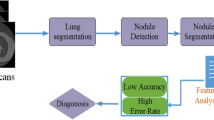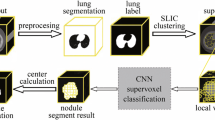Abstract
Lung disease is the premier cause of cancer deaths all over the world. The lung cancer diagnosis is mediocre at an early stage since it is impotent by the radiologist. Various investigations conducted so far manifest clearly that the nodule segmentation algorithms are inefficient. Thus, this investigation has centralized superpixels segmentation based iterative clustering (CSSBIC) and a sophisticated optimization approach for detailed segmentation of pulmonary nodules. The supreme intent of this research paper is the enhancement of lung CT images to identify the tumor effectively and small-scale anomalous nodules segmentation in the lung area. The initial phase an-isotropic diffusion with masking (AIDME) enhancement techniques which can eliminate the noise discern in the images. The next step is to apply the centralized superpixels segmentation based iterative clustering (CSSBIC) algorithm by using an improved picture sequence nodule for abnormal lung tissue prediction. The lung nodule is essentially retrieved using a GWO, based on deep learning techniques, with advanced ONN (ONN) and advanced CNN (CNN). The average time for segmenting the Nodule Slice order is 1.06 s. The best classification accuracy is 97% via GWO based advanced one nearest neighbour (AONN) and 97.6% by GWO based advanced convolutional neural network (ACNN) classifier.










Similar content being viewed by others
References
Alakwaa W, Nassef M, Badr A (2017) Lung cancer detection and classification with 3D convolutional neural network (3D-CNN). Int J Adv Comput Sci Appl 8(8):409–417
Armato SG, Giger CJ, Moran JT, Blackburn K, MacMahon H (1999) Computerized detection of pulmonary nodules on CT scans. Radiographics 19(5):1303–1311
Avinash S, Manjunath K, Senthil Kumar S (2017) An improved image processing analysis for the detection of lung cancer using Gabor filters and watershed segmentation technique. IEEE Trans Image Process 74:178–193
Batenburg KJ, Sijbers J (2009) Optimal threshold selection for tomogram segmentation by projection distance minimization. IEEE Trans Med Imaging 28(5):676–686
Cascio D, Magro R, Fauci F, Lacomi M, Raso G (2012) Automatic detection of lung nodules in CT datasets based on stable 3D mass spring models. Comput Biol Med 42(11):1098–1109
Choi WJ, Cho TS (2014) Automated pulmonary nodule detection based on three-dimensional shape-based feature descriptor. Comput Methods Progr Biomed 113:37–54
Couprie C, Grady L, Najman L, Talbot H (2011) Power watershed: a unifying graph-based optimization framework. IEEE Trans Pattern Anal Mach Intell 33(7):1384–1399
Duda RO, Hart PE, Stork DG (2001) Pattern classification, 2nd edn. Wiley Inter Science, New Jersey
Elizabeth DS, Nehemiah HK, Raj CSR, Kannan A (2012) A novel segmentation approach for improving diagnostic accuracy of CAD systems for detecting lung cancer from chest computed tomography images. J Data Inf Qual 3(2):1–14
Georgiadis P, Cavouras D, Kalatzis I, Daskalakis A, Kagadis GC, Sifaki K, Malamas M, Nikiforidis G, Solomou E (2008) Improving brain tumor characterization on MRI by probabilistic neural networks and non-linear transformation of textural features. Comput Methods Progr Biomed 89(1):24–32
Haney SM, Thompson PM, Cloughesy TF, Alger JR, Toga AW (2001) Tracking tumor growth rates in patients with malignant gliomas: A test of two algorithms. Am J Neuroradiol 22(1):73–82
Hua P, Song Q, Sonka M, Hoffman EA, Reinhardt JM JM (2011) Segmentation of pathological and diseased lung tissue in CT images using a graph-search algorithm. Biomed Imaging, pp 2072–2075
Jiang C, Zhang X, Huang W, Meinel C (2004) Segmentation and quantification of brain tumor. In: Virtual environments, human-computer interfaces and measurement systems (VECIMS), pp 61–66
Kuruvilla J, Gunavathi K (2014) Content based image retrieval for CT images of lungs. Int J Soft Comput 9(6):386–390
Manian V, Vasquez R, Katiyar P (2000) Texture classification using logical operators. IEEE Trans Image Process 9(10):1693–1703
Mathews AB, Jeyakumar MK (2020) Automatic detection of segmentation and advanced classification algorithm. In: 2020 fourth international conference on computing methodologies and communication (ICCMC), Erode, India, 2020, pp 358–362. https://doi.org/10.1109/ICCMC48092.2020.ICCMC-00067
Palani Kumar S, Kumar MS, Rajeesh J (2014) Palmprint enhancement using recursive histogram equalization. Imaging Sci J 61:447–457
Pizer SM, Amburn EP, Austin JD (1987) Adaptive histogram equalization and its variations. Comput Vis Graph Image Process 39:355–368
Rahman MM, Bhattacharya P, Desai BC (2007) A framework for medical image retrieval using machine learning and statistical similarity matching techniques with relevance feedback. IEEE Trans Inf Technol Biomed 11(1):58–69
Ricciardi S, Tomao S, de Marinis F (2011) Efficacy and safety of erlotinib in the treatment of metastatic non-small-cell lung cancer. Lung Cancer Target Ther 2:1–9
Sankar K, Prabhakaran M (2013) An improved architecture for lung cancer cell identification using Gabor filter and intelligence system. Int J Eng Sci 2:38–43
Siva Kumar S, Chandrasekar C (2013) Lung nodule detection using fuzzy clustering and support vector machines. Int J Eng Res Technol 5(1):179–185
Sluimer I, Prokop M, Ginneken BV (2005) Toward automated segmentation of the pathological lung in CT. IEEE Trans Med Imaging 24(8):1025–1038
Song J, Fan L (2016) Lung lesion extraction using a toboggan based growing automatic segmentation approach. IEEE Trans Med Imaging 35(1):337–353
Teramoto A, Tsukamoto T, Kiriyama Y, Fujita H (2017) Automated classification of lung cancer types from cytological images using deep convolutional neural networks. Bio Med Res Int 1–6
Vijila Rani K, Jawhar SJ (2018a) Emerging trends in lung cancer detection scheme—a review. Int J Res Analyt Rev 5(3):530–542
Vijila Rani K, Jawhar SJ (2018b) Novel method for lung tumour detection using wavelet shrinkage-based double classifier analysis. IETE J Res. https://doi.org/10.1080/03772063.2018.1557086
Vijila Rani K, Jawhar J (2019a) Lung lesion classification scheme using optimization techniques and hybrid (KNN-SVM) classifier. IETE J Res. https://doi.org/10.1080/03772063.2019.1654935
Vijila Rani K, Jawhar SJ (2019b) Novel Technology for lung tumor detection using nanoimage. IETE J Res. https://doi.org/10.1080/03772063.2019.1565955
Vijila Rani K, Jawhar SJ (2020) Superpixel with nanoscale imaging and boosted deep convolutional neural network concept for lung tumor classification. Int J Imaging Syst Technol. https://doi.org/10.1002/ima.22422
Vijila Rani K, Thinkal Dayana C, Sujatha Therese P, Eugine Prince M (2020) Triple novelty block detection and classification approach for lung tumor analysis. Int J Imaging Syst Technol. https://doi.org/10.1002/ima.22509
Zhang W, Zhang X, Zhao J, Qiang Y, Tian Q, Tang X (2017) A segmentation method for lung nodule image sequences based on superpixels and density-based spatial clustering of applications with noise. PLoS ONE. https://doi.org/10.1371/journal.phone.0184290
Zuiderveld K (1994) Contrast limited adaptive histogram equalization. In: Graphic gems IV. Academic Press Professional, San Diego, pp 474–485
Acknowledgements
First the authors thank the National Cancer Institute and then acknowledge for free public available online LIDC-IDRI database & in-house clinical ICCN database used in this study. Finally, we wish to thank the anonymous reviewers for helping to strengthen this paper.
Author information
Authors and Affiliations
Corresponding author
Ethics declarations
Conflict of interest
The authors declare that they have no conflict of interest.
Rights and permissions
About this article
Cite this article
Palanikumar, S., Albert Jerome, S. & Jayan, J.P. Automatic detection of solitary pulmonary nodules using superpixels segmentation based iterative clustering approach. J Ambient Intell Human Comput 13, 3103–3118 (2022). https://doi.org/10.1007/s12652-021-03148-2
Received:
Accepted:
Published:
Issue Date:
DOI: https://doi.org/10.1007/s12652-021-03148-2




